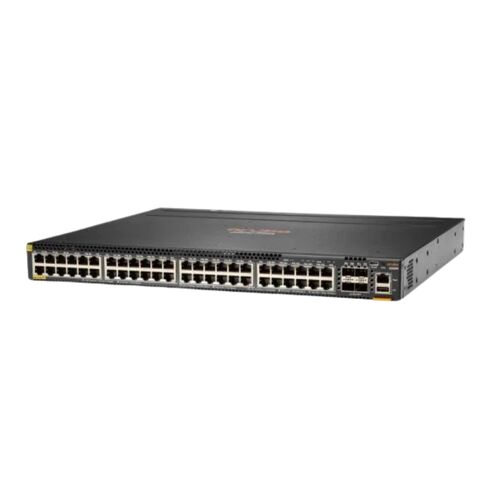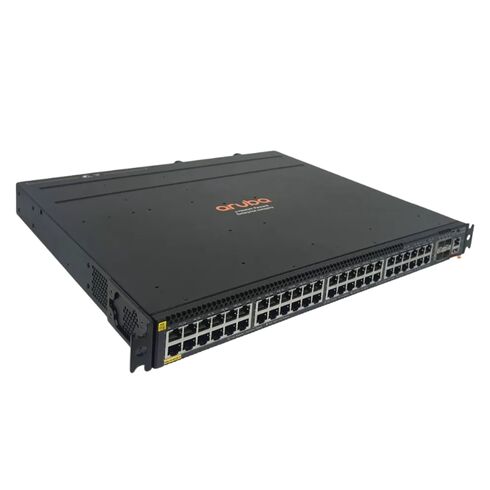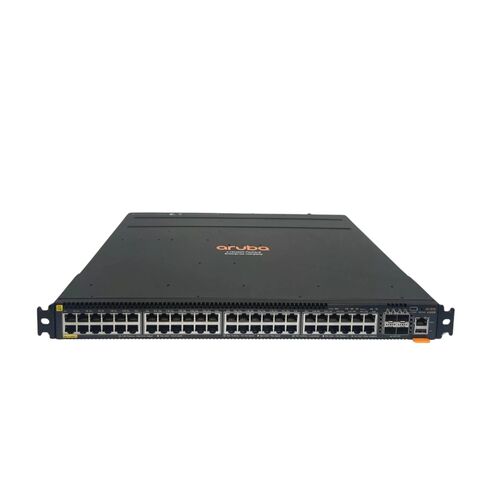JL675A#ABA HPE Aruba 48-Port Managed Network Switch.
- — Free Ground Shipping
- — Min. 6-month Replacement Warranty
- — Genuine/Authentic Products
- — Easy Return and Exchange
- — Different Payment Methods
- — Best Price
- — We Guarantee Price Matching
- — Tax-Exempt Facilities
- — 24/7 Live Chat, Phone Support
- — Visa, MasterCard, Discover, and Amex
- — JCB, Diners Club, UnionPay
- — PayPal, ACH/Bank Transfer (11% Off)
- — Apple Pay, Amazon Pay, Google Pay
- — Buy Now, Pay Later - Affirm, Afterpay
- — GOV/EDU/Institutions PO's Accepted
- — Invoices
- — Deliver Anywhere
- — Express Delivery in the USA and Worldwide
- — Ship to -APO -FPO
- — For USA - Free Ground Shipping
- — Worldwide - from $30
Same product also available in:
| SKU/MPN | Warranty | Price | Condition | You save |
|---|---|---|---|---|
| JL675A#ABA | 1 Year Warranty | $1,520.00 | New Sealed in Box (NIB) | You save: $532.00 (26%) |
| JL675A#ABA | 1 Year Warranty | $1,568.00 | Factory-Sealed New in Original Box (FSB) | You save: $548.80 (26%) |
Product Specifications
Overview of HPE JL675A#ABA
The HPE JL675A#ABA Aruba 6100 series switch is a robust managed solution designed for efficient networking, featuring 48 ports with Power over Ethernet (PoE) capabilities.
Manufacturer Details
- Brand: HPE
- Model Number: JL675A#ABA
- Device Type: Managed Switch
- Port Configuration: 52 Ports
Technical Specifications
Physical Characteristics
- Form Factor: 1U Rack-Mountable with Side-to-Side Airflow
- Cooling Type: Side to Side
Networking Capabilities
- Subtype: 10 Gigabit Ethernet
- Port Types:
- 48 x 10/100/1000 (PoE+)
- 4 x 1 Gigabit / 10 Gigabit SFP+
- Power Over Ethernet (PoE): Yes (PoE+)
- Power Budget: 370 Watts
Performance Metrics
Throughput and Latency
- Switching Capacity: 176 Gbps
- Throughput: 98.6 Gbps
- Latency:
- 1.9 ns (1 Gbps)
- 1.8 ns (10 Gbps)
Routing and Capacity
- Switched Virtual Interfaces (SVIs): 16
- ARP Entries: 1024
- IPv4 Unicast Routes: 512
- IPv6 Unicast Routes: 512
- IGMP Groups: 512
- MAC Address Table Size: 8192 Entries
Security and Protocol Support
Protocols
- Routing Protocols: IGMPv2, IGMPv3
- Authentication Methods:
- Secure Shell (SSH)
- RADIUS
- TACACS+
- Encryption Algorithms: SSL
Management Features
- Flow Control
- VLAN Support
- Multiple Spanning Tree Protocol (MSTP)
- Dynamic Host Configuration Protocol (DHCP) Client
- Network Access Control (NAC)
Expansion and Connectivity Options
Ports and Interfaces
- Base-T RJ-45 Ports: 48 x 10/100/1000 (PoE+)
- SFP+ Ports: 4 x 1/10 Gbit
- Console Interfaces:
- 1 x USB-C
- 1 x USB Type A
Power Specifications
Power Supply Details
- Power Source: Internal Power Supply
- Total Power Provided: 500 Watts
- Voltage Requirements: AC 120/230 V (50/60 Hz)
- Operational Power Consumption: 30.6 Watts
Compliance and Standards
Industry Standards
- IEEE 802.3
- IEEE 802.1d
- IEEE 802.1q
- IEEE 802.3ab
- IEEE 802.3at (PoE+)
- IEEE 802.3az (Energy Efficient Ethernet)
Hardware Specifications
Processor and Memory
- Processor: ARM A9 (1.016 GHz)
- RAM: 4 GB DDR3 SDRAM
- Flash Storage: 16 GB
Ports
The HPE Aruba JL675A#ABA Managed Network Switch is equipped with 48 ports, making it an ideal choice for businesses and organizations that require a high number of network connections. This feature provides users with numerous benefits and plays a crucial role in ensuring efficient and reliable network connectivity.
Increased Connectivity
With 48 ports, this switch offers an extensive range of connectivity options. It allows users to connect multiple devices, such as computers, servers, printers, and IP phones, simultaneously. This is particularly advantageous for businesses with a large number of employees or departments that heavily rely on network-dependent operations.
Scalability
The abundance of ports on the HPE Aruba JL675A#ABA Managed Network Switch enables businesses to scale their network infrastructure as their needs grow. Whether it's expanding the workforce, adding new devices, or accommodating new departments, the switch can easily handle the increased demand for connectivity without compromising performance.
Flexibility
Having 48 ports provides users with the flexibility to organize their network connections effectively. It allows for better segregation of devices and enables the implementation of VLANs (Virtual Local Area Networks) to isolate traffic for security or performance purposes. Additionally, it offers more room for future expansion or reconfiguration of the network setup.
Improved Performance
The ample number of ports ensures that each connected device receives sufficient bandwidth and avoids congestion. This helps maintain optimal performance levels even during peak network usage. Users can enjoy seamless data transfer, faster file sharing, and smoother multimedia streaming without experiencing any slowdowns or bottlenecks.
Reduced Need for Additional Equipment
By providing 48 ports in a single switch, the HPE Aruba JL675A#ABA eliminates the need for additional networking equipment, such as switches or hubs. This not only saves cost but also simplifies network management and reduces potential points of failure. With fewer devices to maintain, troubleshoot, and upgrade, users can streamline their network infrastructure and improve overall efficiency.
Centralized Network Management
Consolidating multiple connections into a single switch enables centralized network management. Administrators can easily monitor and configure all connected devices through the switch's management interface. This level of control simplifies troubleshooting, enhances security measures, and facilitates the implementation of network-wide policies.
Management Interface
The HPE Aruba JL675A#ABA Managed Network Switch offers a variety of management interfaces, including a web interface, CLI (Command-Line Interface), and SNMP (Simple Network Management Protocol). This feature empowers users with different preferences and expertise to efficiently manage and control their network.
Web Interface
The web interface provides a user-friendly graphical interface for managing the switch. It allows administrators to configure settings, monitor performance, and troubleshoot issues using a web browser. This intuitive interface eliminates the need for specialized software or technical expertise, making it accessible even to less experienced users.
Visual Representation
The web interface often includes visual representations of the network topology, making it easier to understand and navigate the network infrastructure. Administrators can view the connections between devices, monitor port statuses, and quickly identify any potential issues or bottlenecks. This visual representation enhances network management efficiency and facilitates troubleshooting.
Remote Management
The web interface enables remote management of the switch, eliminating the need for physical access to the device. Administrators can securely access and configure the switch from anywhere with an internet connection. This feature is particularly beneficial for businesses with multiple locations or remote branches as it saves time and travel costs associated with on-site management.
User-Friendly Configuration
The web interface simplifies the configuration process by providing an intuitive interface with easily understandable options and settings. Administrators can quickly set up VLANs, QoS (Quality of Service) policies, and other network parameters without the need for complex command-line configurations. This user-friendly approach reduces the likelihood of errors and speeds up the deployment of network changes.
Real-Time Monitoring
The web interface often includes real-time monitoring capabilities, allowing administrators to track network performance metrics such as bandwidth utilization, error rates, and packet loss. This valuable information helps identify potential bottlenecks, troubleshoot issues promptly, and optimize network resources for better overall performance.
Alerts and Notifications
Many web interfaces offer customizable alerts and notifications, keeping administrators informed about critical events or abnormal network behavior. These notifications can be sent via email or SMS, ensuring that administrators are promptly alerted to potential issues or security breaches. This proactive approach to network management minimizes downtime and improves overall network reliability.
Power Over Ethernet (PoE) Support
The HPE Aruba JL675A#ABA Managed Network Switch features Power Over Ethernet (PoE) support, providing significant benefits and convenience for users who need to power network devices directly from the switch.
Simplified Deployment
PoE support eliminates the need for separate power adapters or electrical outlets for connected devices. Users can power devices such as IP phones, wireless access points, security cameras, and IoT (Internet of Things) devices directly from the switch using Ethernet cables. This streamlined deployment process saves time, reduces clutter, and facilitates flexible device placement.
Cost Savings
By utilizing PoE support, users can save on the cost of additional power adapters or electrical wiring. The switch's built-in power capabilities eliminate the need for expensive electrical work during network expansion or device installation. Additionally, it reduces energy consumption by allowing centralized power management, leading to potential cost savings in electricity bills.
Reliable Power Delivery
PoE support ensures a reliable power supply to connected devices. The switch continuously monitors power usage and dynamically allocates power based on device requirements. This intelligent power management prevents overloading and protects devices from power surges or fluctuations. Users can confidently rely on the switch to provide a stable power source for their network devices.
Flexibility and Mobility
PoE support enables greater flexibility in device placement as it eliminates the dependence on nearby electrical outlets. Users can deploy devices in areas where power outlets are scarce or inconveniently located, such as ceilings, walls, or outdoor environments. This flexibility allows for optimal device positioning for better network coverage and performance.
Centralized Power Management
With PoE support, administrators can centrally manage power allocation and monitoring for all connected devices. The switch's management interface allows for fine-grained control over power settings, such as prioritizing power delivery to critical devices or setting power schedules for energy efficiency. This centralized approach simplifies power management and ensures optimal utilization of available power resources.
Remote Power Cycling
PoE support enables remote power cycling of connected devices through the switch's management interface. Administrators can remotely restart or reset devices without physical access, saving time and effort in troubleshooting or resolving device issues. This feature is particularly valuable for businesses with distributed networks or remote locations where on-site maintenance may not be readily available.
Rack Mountable
The HPE Aruba JL675A#ABA Managed Network Switch is designed to be rack mountable, offering users convenience, organization, and efficient space utilization.
Space Efficiency
Rack mountable switches allow users to optimize their network infrastructure by vertically stacking multiple switches in a standardized rack enclosure. This stacking arrangement maximizes the use of limited space, making it ideal for data centers, server rooms, or network closets with space constraints. Rack mounting eliminates the need for additional shelves or cabinets, resulting in a more organized and compact network setup.
Cable Management
Rack mountable switches often come with integrated cable management features, such as cable trays or routing guides, that help keep cables organized and reduce clutter. This systematic approach to cable management improves airflow and reduces the risk of cable damage or accidental disconnections. It also simplifies troubleshooting and maintenance by providing clear visibility and access to cables.
Scalability
Rack mountable switches facilitate easy scalability as additional switches can be seamlessly added to the rack when needed. This modular approach allows businesses to expand their network infrastructure without major disruptions or the need for extensive rewiring. Users can simply mount new switches in the available rack space and connect them to the existing network, ensuring a smooth transition during network growth.
Easy Maintenance
Rack mountable switches simplify maintenance tasks by providing easy access to individual switches within the rack enclosure. Administrators can quickly replace or upgrade switches without disturbing other components or interrupting network operations. This accessibility reduces downtime during maintenance activities and minimizes the impact on overall network availability.
Physical Security
Rack mountable switches offer enhanced physical security as they can be installed in locked rack enclosures or cabinets. This prevents unauthorized access or tampering with critical network equipment. Additionally, it allows for centralized monitoring and control of physical access to the switch, further strengthening security measures for sensitive network environments.
Improved Cooling
Rack mounting enables better airflow management within the rack enclosure. Switches installed in a rack benefit from the enclosure's built-in ventilation system, ensuring proper cooling and preventing overheating. This improved airflow reduces the risk of equipment failure due to excessive heat and helps maintain the switch's performance and reliability.
Layer
The HPE Aruba JL675A#ABA Managed Network Switch operates at Layer 3 of the OSI (Open Systems Interconnection) model, providing users with advanced networking capabilities and extensive control over their network environment.
Enhanced Network Segmentation
Operating at Layer 3 allows for the implementation of VLANs, which enable network segmentation based on logical or departmental requirements. Users can isolate traffic between different VLANs, effectively separating departments or user groups for security, performance, or compliance purposes. This granular control enhances network management and reduces potential security risks.
Improved Routing Efficiency
Layer 3 switches can perform routing functions, allowing for efficient traffic forwarding between different VLANs or subnets. This eliminates the need for an external router, reducing complexity and potential points of failure in the network. Users can benefit from faster data transmission, reduced latency, and improved overall network performance.
Quality of Service (QoS)
Layer 3 switches support advanced QoS features, enabling users to prioritize network traffic based on specific criteria such as application type, user priority, or latency requirements. This ensures that critical applications or services receive sufficient bandwidth and are not affected by low-priority traffic. The ability to prioritize traffic at Layer 3 enhances overall network performance and user experience.
Better Scalability
Layer 3 switches offer better scalability compared to lower-layer switches. They can handle larger networks with multiple subnets or VLANs without compromising performance. As businesses grow or network demands increase, Layer 3 switches provide the necessary flexibility and capacity to accommodate expanding requirements.
Inter-VLAN Routing
Layer 3 switches can perform inter-VLAN routing, allowing traffic to be routed between different VLANs within the switch itself. This eliminates the need for an external router and simplifies network design and management. Users can efficiently control and route traffic between VLANs, improving network performance and reducing the reliance on additional networking equipment.
IPv6 Support
Layer 3 switches typically offer comprehensive support for IPv6, the latest version of the Internet Protocol. This ensures compatibility with modern networks that increasingly adopt IPv6 addressing. IPv6 support future-proofs the network infrastructure and enables seamless integration with other IPv6-enabled devices or services.
Stackable
The HPE Aruba JL675A#ABA Managed Network Switch features stackable capabilities, allowing users to combine multiple switches into a single logical unit. This feature provides several benefits and facilitates efficient network management.
Simplified Management
Stackable switches can be managed as a single entity, simplifying network management tasks. Administrators can configure settings, monitor performance, and troubleshoot issues across multiple switches simultaneously. This centralized management approach reduces the complexity associated with managing individual switches, saving time and effort in day-to-day network operations.
Increased Availability
Stacking multiple switches enhances network availability by providing redundancy and failover capabilities. In the event of a switch failure, the remaining switches in the stack can seamlessly take over the workload, ensuring uninterrupted network connectivity. This high availability feature is particularly critical for businesses that rely heavily on their network infrastructure to support mission-critical applications or services.
Enhanced Performance
Stacking switches enables load balancing and link aggregation across multiple physical connections. This distributes network traffic evenly and optimizes bandwidth utilization, resulting in improved network performance. The combined bandwidth of all stacked switches provides higher throughput and reduces bottlenecks, allowing for faster data transfer and better overall user experience.
Simplified Expansion
Stackable switches facilitate easy expansion of the network as additional switches can be seamlessly added to the existing stack. This modular approach allows businesses to scale their network infrastructure without major disruptions or the need for complex configurations. Users can simply connect new switches to the stack, and they will automatically inherit the configuration and settings of the existing stack.
Flexible Topology
Stackable switches offer flexibility in network topology design. Users can choose between ring or star topologies based on their specific requirements or preferences. The ring topology provides redundancy and fault tolerance, while the star topology simplifies cable management and offers more efficient use of available ports. The ability to choose the desired topology enhances network design flexibility and adaptability.
Cost-Effective Scalability
Stackable switches provide a cost-effective approach to network scalability. Instead of investing in standalone switches, users can incrementally expand their network by adding additional switches to the existing stack. This eliminates the need for separate management interfaces, reduces cabling complexity, and minimizes overall equipment costs. Users can scale their network according to their needs without incurring unnecessary expenses.













